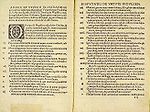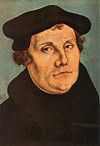The Ninety-Five Theses
| Latin Wikisource has original text related to this article: |
| Wikisource has original text related to this article: |
The 95 Theses on the Power and Efficacy of Indulgences (Latin: Disputatio pro declaratione virtutis indulgentiarum), commonly known as The Ninety-Five Theses, was written by Martin Luther in 1517 and is widely regarded as the primary catalyst for the Protestant Reformation. The disputation protests against clerical abuses, especially in regard to indulgences.
Contents |
[edit] Background
| Protestant Reformation |
Denmark-Norway and Holstein · England |
|
|
The background to Luther's Ninety-Five Theses centers on agreements within the Catholic Church regarding baptism and absolution. Significantly, the Theses offer a view on the validity of indulgences (remissions of temporal punishment due for sins which have already been forgiven). They also view with great cynicism the practice of indulgences being sold, and thus the penance for sin representing a financial transaction rather than genuine contrition. Luther's theses argued that the sale of indulgences was a gross violation of the original intention of confession and penance, and that Christians were being falsely told that they could find absolution through the purchase of indulgences.
The Castle Church in Wittenberg, Germany, in the Holy Roman Empire, where the Ninety-Five Theses famously appeared, held one of Europe's largest collections of holy relics. These had been piously collected by Frederick III of Saxony. At that time pious veneration, or viewing, of relics was purported to allow the viewer to receive relief from temporal punishment for sins in purgatory. By 1509 Frederick had over 5,000 relics, purportedly "including vials of the milk of the Virgin Mary, straw from the manger [of Jesus], and the body of one of the innocents massacred by King Herod."[1]
As part of a fund-raising campaign commissioned by Pope Leo X to finance the renovation of St. Peter's Basilica in Rome, Johann Tetzel, a Dominican priest, began the selling of indulgences in the German lands. Albert of Mainz (the Archbishop of Mainz) in Germany had borrowed heavily to pay for his high church rank and was deeply in debt. He agreed to allow the sale of the indulgences in his territory in exchange for a cut of the proceeds. Luther was apparently not aware of this. Even though Luther's prince, Frederick III, and the prince of the neighboring territory, George, Duke of Saxony, forbade the sale in their lands, Luther's parishioners traveled to purchase them. When these people came to confession, they presented their plenary indulgences which they had paid good silver money for, claiming they no longer had to repent of their sins, since the document promised to forgive all their sins. Luther was outraged that they had paid money for what was theirs by right as a free gift from God. He felt compelled to expose the fraud that was being sold to the pious people. This exposure was to take place in the form of a public scholarly debate at the University of Wittenberg. The Ninety-five Theses outlined the items to be discussed and issued the challenge to any and all comers. The 95 theses were written into a book.
[edit] Initial dissemination

According to a report written by Philipp Melanchthon, Luther posted the Ninety-five Theses at the Castle Church in Wittenberg, Germany on October 31st, 1517. Some scholars have questioned the accuracy of this account, noting that no contemporaneous evidence exists for it.[2] Others have countered that no such evidence is necessary, because this action was the customary way of advertising an event on a university campus.[3] Church doors at the time functioned very much as bulletin boards. Still others suggest the posting may well have happened sometime in November 1517. When referring to the 95 Theses, it is nevertheless quite safe to say that they were posted on October 31, 1517, on a church door. The day of October 31 is All Hallow's Eve, and, since on the following day (All Saints) most people will go to church, posting his theses on this day makes sense.[4]
[edit] Reaction to the Ninety-Five Theses
According to some, the Ninety-Five Theses gained enormous popularity over a very short period of time. Luther's ideas resonated with people regardless of class, status, or wealth, at a time when such concepts were crucial to the social order.[5]
On June 15, 1520, Pope Leo X issued a rebuttal to Luther's 95 Theses, a papal encyclical entitled Exsurge Domine. This document outlined the Magisterium of the Catholic Church's findings of where Luther had erred.
Some of the theological concepts which Luther raised still divide the Christian Church today. These questions plagued Luther, who often resorted to mortification of the flesh[citation needed] so as to attempt to be perfectly contrite before God. Erasmus counseled Luther to wait until scholarship was sufficient to permit reform to be more accurate than a total dependence on the Bible[citation needed], which generated Anabaptism, Protestantism, and, in the modern era, evangelicalism. Meanwhile, Luther's Theses became a declaration of independence in Northern Europe, around which rallied enormous social changes, like the decline of feudalism, and the rise of commercialism. As early as October 27, 1521, the chapel at Wittenberg suppressed private Masses. In 1522, much of the city began celebrating Lutheran services instead of Roman Catholic. Luther's popularity grew rapidly, mostly due to the general Roman Catholic church member's dissatisfaction with the corruption and "worldly" desires and habits of the Roman Curia.[6][7][8]
[edit] References
- ^ Martin Treu, Martin Luther in Wittenberg: A Biographical Tour (Wittenberg: Saxon-Anhalt Luther Memorial Foundation, 2003), 15.
- ^ Iserloh, Erwin. The Theses Were Not Posted. Toronto: Saunders of Toronto, Ltd., 1966.
- ^ Helmar Junghans, "Luther's Diary," in The Cambridge Companion to Martin Luther, ed. Donald K. McKim (New York: Cambridge University Press, 2003), 26
- ^ Junghans, 26.
- ^ Edwards, Mark. Luther: A Reformer for the Churches. Philadelphia: Fortress Press, 1983.
- ^ "Wittenberg". The Catholic Encyclopedia. New Advent. http://www.newadvent.org/cathen/15678b.htm. Retrieved 2009-10-31.
- ^ "Martin Luther". The Catholic Encyclopedia. New Advent. http://www.newadvent.org/cathen/09438b.htm. Retrieved 2009-10-31.
- ^ "Condemning the Errors of Martin Luther: Exsurge Domine: Bull of Pope Leo X". Papal Encycles Online. 1520-06-15. http://www.papalencyclicals.net/Leo10/l10exdom.htm. Retrieved 2009-10-31.
[edit] Bibliography
- Erwin Iserloh The Theses Were Not Posted: Luther Between Reform and Reformation. trans. by Jared Wicks, S.J.. Boston: Beacon Press, 1968.
- Palmer, R.R. A History of the Modern World. New York: McGraw Hill, 2002
[edit] External links
- Full Latin Text: 95 Theses by Martin Luther (1517)
- Full English Text: 95 Theses
- BELIEVE Religious Information Source
|
||||||||||||||||||||||||||||||||||||||||||||||||||||||||||||||||||||



